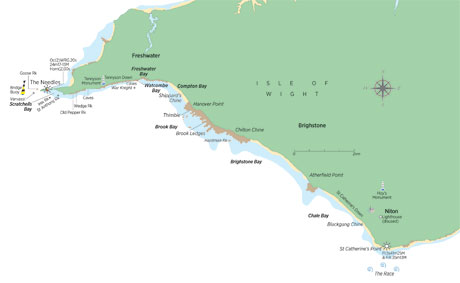The Needles

The Needles are perhaps the most distinctive coastal feature in the UK, three jagged saw-teeth of chalk jutting out into Christchurch Bay with a famous lighthouse marking the western extremity of the Isle of Wight. I never thought of The Needles as a particularly suitable name for the feature but early 17th Century charts show a series of needle-like chalk stacks on the The Needles’ northern side. Last of these was a 37m (120ft) chalk spike known variously as Lot’s Wife and Cleopatra’s Needle, and it collapsed in 1764 with a roar that was heard in Portsmouth.
The Needles are part of the east-west spine of chalk that runs through the island, under Newport, emerging at Culver Down. There is a chalk ledge, or bridge, running out from the Needles to Bridge buoy, sounding between 3-10m, which causes overfalls. This ledge is all that remains of the chalk spine that used to run across Christchurch Bay, linking to Old Harry Rocks in the Isle of Purbeck, when the island was still linked to the mainland.
Halfway along this chalk ledge, in 5m CD, lies the wrecked bow of the 3,677-ton, 350ft SS Serrana. She was en route from London to Barbados when she was torpedoed by Oberleutnant Karl Stoeter’s UB-35 in 22 January 1918. She made it to the Needles ledge before breaking her back and sinking, leaving just two survivors. Two days earlier UB35 had torpedoed the 9,044-ton, 500ft SS Mechanician. She limped onto the Shingles Bank where she was abandoned and gradually swallowed by the shifting stones.

Perhaps the Island’s most infamous wreck is the 3,874-ton, 375ft Greek cargo vessel Varvassi. She was bound from Algiers to Southampton with 300 tons of tangerines and Algerian wine when she mysteriously ran aground at three knots in perfect weather on 5 January 1947, despite sound and light signal warnings from the pilot waiting to escort her in. Attempts were made to refloat her but these were abandoned overnight. The following day, with a gale building and waves threatening to wash her officers off the bridge, the decision was made to rescue the 36 crew and salvage the cargo. Yarmouth’s lifeboat, called to the wreck for the third time in 24 hours, showed incredible skill and courage in getting every last one of them off, including the ship’s black and white cat, which was presented to the landlord of the King’s Head Hotel in Yarmouth.

All that remains of the Varvassi are four lumps of iron, the tallest of which is an upended boiler, close to the light. Goose Rock is closest.




